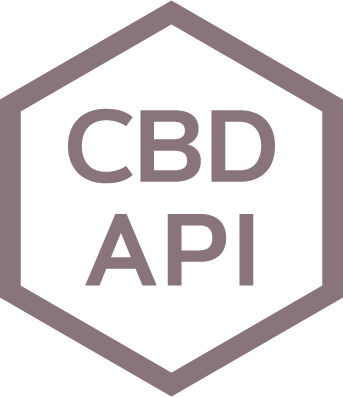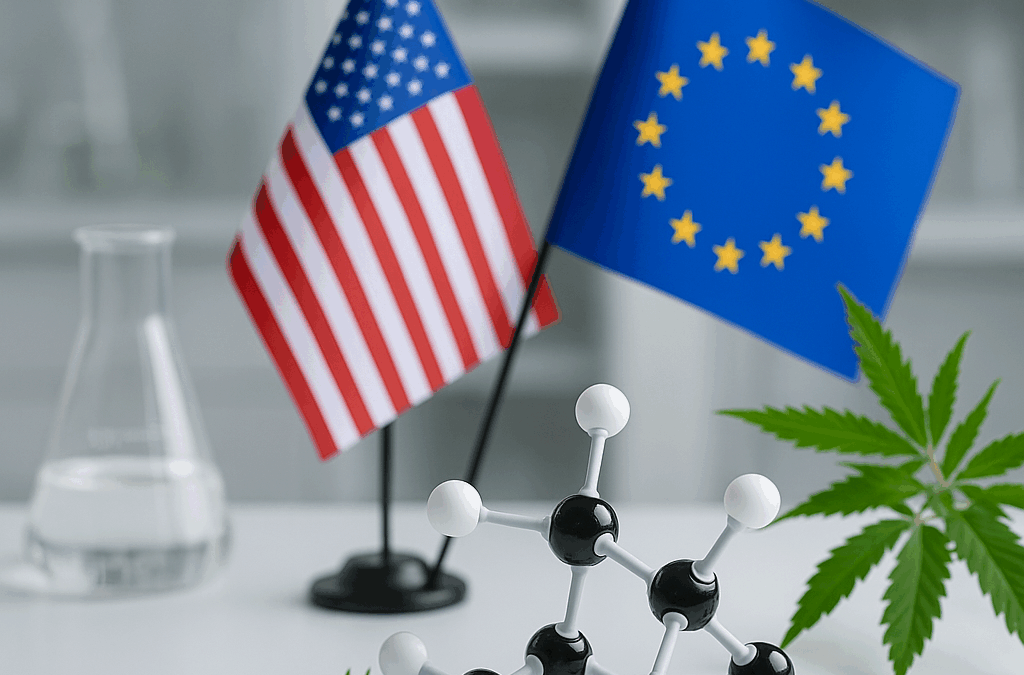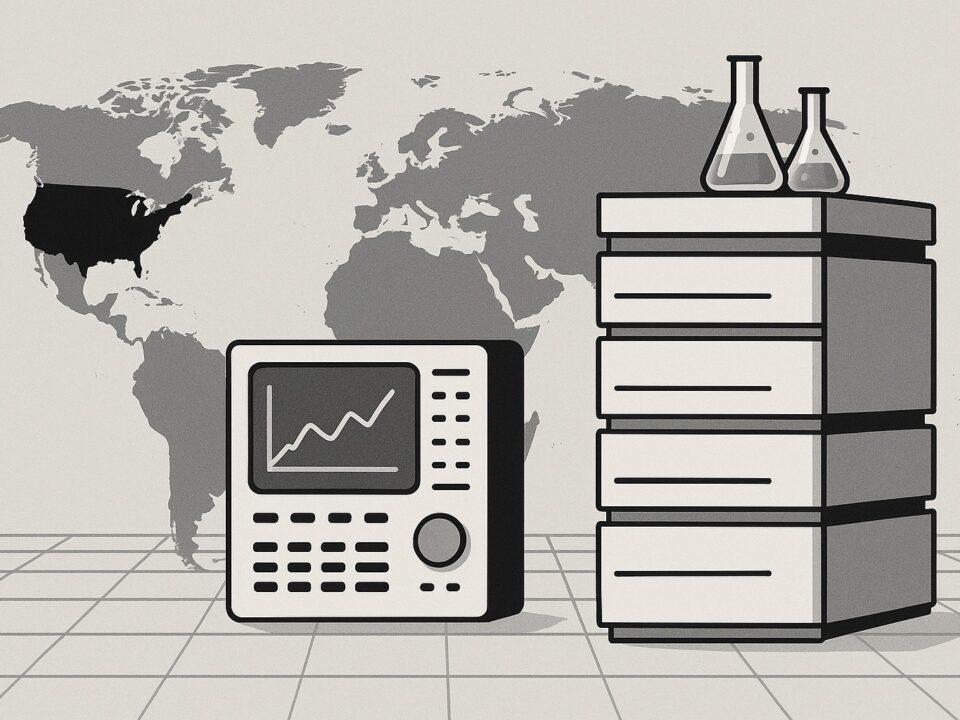
Cannabidiol – Alzheimer’s Clinical Trials
July 24, 2025
The Certification Gap for Hemp Labs
September 26, 2025Key Differences in CBD Regulations: United States vs. European Union
Navigating the regulatory landscape for CBD (cannabidiol) products is complex – especially when comparing frameworks in the United States and the European Union. Here are five significant differences in US/EU CBD regulations, with insights into quality control, medicines and marketing, and real-world regulatory enforcement.
1. Hemp Cultivation & THC Limits: US Farm Bill vs. EU Policy
THC Thresholds and Cultivation Rules: In the United States, the 2018 Farm Bill federally legalized the cultivation of “industrial hemp,” defining it as cannabis with <0.3% THC (tetrahydrocannabinol) by dry weight. This removed hemp from the Controlled Substances Act, spurring a boom in hemp-derived CBD production. Hemp growers in the US must comply with USDA regulations, including testing crops for THC content; if a crop exceeds 0.3% THC (often termed “hot” hemp), it is classified as marijuana and must be destroyed. In fact, the USDA initially estimated that about 20% of hemp lots could test above 0.3% THC and require destruction under these rules. Enforcement is strict: farmers have faced the loss of entire crops when THC limits are exceeded, though the USDA provides a negligence threshold (up to ~0.5% THC) before it’s considered a willful violation. Each state, under federal guidelines, licenses hemp growers and conducts or oversees compliance testing, sometimes in DEA-registered labs, to ensure the 0.3% THC limit and prevent illicit cannabis from entering commerce.
In the EU, the allowable THC content in hemp has historically been even lower. Until recently, EU regulations capped hemp at 0.2% THC for approved cultivation. This threshold was set in EU law (Reg. 1307/2013) mainly to qualify for agricultural subsidies and ensure hemp crops are non-intoxicating. However, recognizing evolving market conditions, the EU has updated its Common Agricultural Policy rules to raise the THC limit to 0.3% in line with international norms. Under the EU’s rules, farmers must use certified hemp seed varieties listed in the EU common catalogue – these varieties are bred to stay under the THC threshold. EU member states conduct THC testing in the field; if a crop exceeds the limit, farmers can lose subsidy eligibility or face destruction orders under national laws. (For example, Italy and France have enforced limits by seizing or ordering the destruction of “hemp” that in practice tested over the legal THC percentage.) Notably, EU law allows member countries to impose more restrictive rules if they choose, which has led to slight national variations – e.g., Italy for a time tolerated up to 0.6% THC in “industrial cannabis” under a legal grey area, whereas others strictly enforce 0.2% or 0.3%.
Quality Control in Cultivation: Both regions emphasize quality control at the cultivation stage albeit in different ways. In the US, the USDA’s hemp program (7 CFR Part 990) requires sampling and testing of hemp flowers prior to harvest to ensure compliance. Many state regulations also mandate Good Agricultural Practices (GAP) and testing for contaminants (pesticides, heavy metals) as part of licensing. In the EU, aside from THC limits, certification of seeds and traceability of cultivation are key quality measures – only varieties proven to consistently produce low THC are allowed, and farms are subject to inspections. The EU also harmonized maximum THC residue levels in food products in 2023 (e.g., setting THC limits in hempseed oil and other hemp foods) to ensure consumer safety. This means that even for hemp foods, European producers must rigorously control THC content and other quality parameters. Both the U.S. and EU thus tackle quality at the source: the U.S. with a compliance-or-destroy approach on THC and states’ testing requirements, and the EU with certified seed rules and unified THC standards across member states.
Enforcement Example – France: A recent enforcement saga in France highlights how THC limits and hemp part usage are policed by different CBD regulations in the EU. In late 2021, France attempted to ban the sale of hemp flower and leaf products outright (even if they contained <0.3% THC), citing public health concerns. This was met with legal challenges. By December 2022, France’s highest administrative court (Conseil d’État) overturned the ban as disproportionate, noting that low-THC hemp flower posed no proven risk to public health. Crucially, the court pointed to a 2020 European Court of Justice ruling which held that CBD is not a narcotic and EU member states may not forbid the marketing of lawfully produced CBD from hemp (i.e. from an EU country) on drug grounds. As a result, France had to allow hemp CBD flower on the market (with THC <0.3%), illustrating how EU-wide principles (free movement of goods and harmonized definitions of hemp) constrain national enforcement. This contrasts with the U.S., where no such federal protection exists for CBD products sold in interstate commerce if they fall outside the hemp definition or other FDA regulations. In summary, the THC threshold difference (0.3% vs 0.2% historically) and the approach to enforcement (U.S.’s Farm Bill with strict testing vs. EU’s CAP rules with seed certification and pan-EU legal principles) mark a clear regulatory difference affecting hemp cultivation and raw material sourcing for CBD.
2. Oversight Agencies & Regulatory Framework: FDA vs. EMA (and Others)
Primary Regulatory Bodies: In the United States, multiple agencies share oversight of CBD depending on its use. The U.S. Food and Drug Administration (FDA) is the chief regulator for products intended for human or animal consumption or treatment. The FDA’s mandate covers drug approval, food safety, dietary supplements, and cosmetics, all of which intersect with CBD products. For example, the FDA approved one prescription CBD-based drug (Epidiolex) in 2018 and thus considers any CBD intended to treat diseases as a drug requiring approval. It also maintains that CBD cannot be freely added to foods or marketed as a dietary supplement without new regulations, due to safety concerns and the fact that CBD was first approved as a drug (triggering the “exclusion” rule under the FD&C Act). In addition to the FDA, the USDA oversees hemp cultivation as noted, and agencies like the DEA remain involved if CBD products contain excess THC or are derived from marijuana (cannabis >0.3% THC, still a Schedule I substance federally). Moreover, individual state regulators (health departments, agriculture departments, or dedicated cannabis control boards) enforce rules for CBD product testing, labeling, and sale within their jurisdictions – leading to a patchwork of standards. For instance, some states require QR codes linking to lab test results on CBD product labels, and a few have banned certain hemp-derived cannabinoids like Delta-8 THC due to safety concerns, despite federal law.
In the European Union, the regulatory landscape for CBD is likewise multifaceted but tends to be more coordinated across member states. The European Medicines Agency (EMA), through the Committee for Medicinal Products for Human Use (CHMP), oversees the approval of CBD-containing medicinal products (pharmaceuticals). A notable example is Epidyolex (same formulation as Epidiolex), which EMA approved in 2019 for severe epilepsy – making it a regulated prescription medicine EU-wide. When CBD is used or marketed for therapeutic purposes, national medicines regulators (such as Germany’s BfArM, Italy’s AIFA, etc.) and the EMA come into play to ensure it meets efficacy, safety, and quality requirements equivalent to any other medicine. Separately, for food and supplements, the EU’s regulatory framework classifies CBD (when isolated or in extracts) as a “novel food.” This falls under the jurisdiction of the European Food Safety Authority (EFSA) and the European Commission. Since CBD was not significantly consumed in foods in the EU before 1997, any edible CBD product requires a novel food authorization – a rigorous pre-market safety evaluation. EFSA has been evaluating several novel food applications for CBD, but as of 2022 it highlighted significant safety data gaps (e.g. effects on the liver, reproductive system, etc.) and has not yet approved any application. Thus, EU authorities (both at the EU level and within member states) generally do not allow CBD in foods or dietary supplements until an authorization is granted. Member states’ food safety agencies have been enforcing this; for example, in Germany and Austria, authorities have removed CBD-infused candies and beverages from stores for lacking novel food approval, and in the UK (post-Brexit), the Food Standards Agency has only permitted companies with pending novel food dossiers to keep products on the market, warning others to comply or face enforcement.
Enforcement Approaches: The FDA’s approach to CBD has been one of caution and case-by-case enforcement. Since 2015, the FDA has issued numerous warning letters to companies marketing CBD in violation of the law – commonly targeting unsubstantiated health claims (e.g., claims to cure cancer or treat Alzheimer’s) and the unlawful addition of CBD into foods or dietary supplements. For instance, in November 2023 the FDA sent a series of warning letters to companies selling CBD-infused foods (baked goods, drinks, gummies), explicitly stating that CBD is not generally recognized as safe (GRAS) for use in food and thus any food containing it is considered “adulterated” under the FD&C Act. This was a shift to enforcing the food additive law, complementing earlier actions mostly about disease claims (unapproved new drugs). The FDA, along with the Federal Trade Commission (FTC), has also cracked down on misleading marketing – for example, jointly warning several firms in July 2023 about illegal Delta-8 THC products and CBD edibles that were packaged in child-attractive forms. These enforcement actions show that while the FDA has not banned consumer CBD products outright, it is actively policing safety and honesty in the marketplace, especially when products appear unsafe (e.g. CBD in food or marketed to children) or when therapeutic claims cross the line.
In the EU, enforcement is somewhat split between ensuring products are not narcotic drugs and ensuring novel food compliance (or medicinal compliance if applicable). Because EU law now clearly says CBD extracted from hemp is not a drug as long as THC is under control, enforcement against CBD per se often hinges on other factors: for example, authorities will intervene if a CBD product has measurable THC above legal limits (treating it as an illicit drug), if it’s marketed with medical claims without authorization (treating it as an unlicensed medicine), or if it’s a food product without novel food approval. National food safety authorities in countries like Spain and Italy have issued orders to stop sales of CBD oils labeled as dietary supplements on the basis that they are unauthorized novel foods. Additionally, there have been police seizures of CBD flowers or oils in some countries under narcotics laws, but courts are increasingly aligning with the ECJ stance that hemp-derived CBD is not a narcotic. A case in point: Italy’s courts had to wrestle with the “cannabis light” shops selling CBD-rich hemp flower; initially, law enforcement seized products, but judges later ruled that if the product cannot cause intoxication (e.g., THC below ~0.5%), it does not fulfill the offense of distributing narcotics. This patchwork of enforcement in the EU is gradually leveling out as EU-wide guidance (like the novel food catalogue entry and the ECJ rulings) takes effect. In summary, the FDA serves as a single federal watchdog in the U.S. (supplemented by state actions), whereas the EU relies on a combination of EMA (medicines) and EFSA/European Commission (foods) guidelines, implemented by each member state’s authorities. Both frameworks are actively evolving, and regulators on both sides have shown a willingness to intervene (through warning letters, seizures, or court actions) when CBD products pose public health or legal compliance issues.
Quality Control & GMP Standards: A key difference – especially relevant for pharmaceutical-grade CBD – is how quality control is regulated through Good Manufacturing Practices (GMP). The FDA requires any CBD drug product (like Epidiolex) or active pharmaceutical ingredient (API) to be manufactured under stringent pharmaceutical GMP standards, specifically 21 CFR Parts 210 and 211 which govern the manufacturing, processing, packing, and holding of drugs. These regulations ensure product quality, purity, potency, and consistency – including requirements for quality control units, batch testing, stability testing, proper documentation, etc. For dietary supplements (if CBD were to be legally treated as one in the future or as some companies attempt now), 21 CFR Part 111 cGMP would apply, and for foods, 21 CFR Part 117 (food GMP and preventive controls) would apply. In practice, leading U.S. CBD API manufacturers are already voluntarily adhering to pharmaceutical GMP standards. For example, Vantage Hemp Co. in Colorado announced in 2023 that it operates to FDA 21 CFR 210/211 and ICH Q7 standards and filed Drug Master Files with the FDA for its CBD isolates and distillates. This reflects an industry recognition that pharma-grade CBD must meet global quality benchmarks to be viable in medicines.
On the EU side, any CBD intended as an API for medicinal products must similarly be produced under EU Good Manufacturing Practice (EU-GMP) standards. The EU’s GMP rules (EudraLex Volume 4) are very aligned with US standards, including Part I for finished products and Part II (based on ICH Q7) for APIs. In countries like Germany, where a robust medical cannabis program exists, pharmaceutical-grade CBD is treated like any other active substance – manufacturers must undergo inspections and obtain EU GMP certification for their facilities. A real example: a North American company exporting >99% pure CBD isolate to Germany had to pass an EU inspection against ICH Q7 (the international GMP guideline for APIs) to be accepted, ensuring everything from raw material controls to impurity testing met EU standards. One interesting nuance is that while finished medicinal products in the EU require each batch to be released by a Qualified Person (QP) in the EU, an imported API like CBD isolate does not require QP batch release if it’s not a finished product – the responsibility is to ensure the API comes from a GMP-certified source. Still, European importers will test the API and require documentation such as Certificates of Analysis (including verification that THC is below detection or within legal limits). Additionally, the European Pharmacopoeia has recently added a monograph for Cannabidiol (monograph 3151, official as of July 2024), which sets identity and purity standards for CBD as a substance. EU API suppliers or importers must ensure their product meets these pharmacopeial quality specifications (for example, impurity limits, residual solvents, etc.). These measures underscore that the quality control mechanisms are stringent on both sides for pharmaceutical CBD: the U.S. via FDA’s cGMP regulations (21 CFR 210/211) and Drug Master File transparency, and the EU via mandatory EU-GMP certification and pharmacopoeial standards. For non-pharmaceutical CBD products, however, the U.S. currently lacks specific federal quality standards (other than general food/supplement GMPs) while the EU’s novel food process essentially forces a pre-market quality and safety review for each product.
3. Legal Classification: CBD as Dietary Supplement, Food Additive, or Medicine
A critical difference between the U.S. and EU lies in how CBD products are classified and allowed on the market – either as foods/supplements or as medicines – and the regulatory pathways (or lack thereof) for each category.
United States – Dietary Supplement Grey Zone: In the U.S., many CBD products are marketed as dietary supplements or wellness products, but this is a regulatory gray area. By law, under the Federal Food, Drug, and Cosmetic Act, an ingredient that has been first approved or investigated as a drug cannot be marketed as a dietary supplement or added to conventional foods without FDA authorization. Since CBD was approved as the active ingredient in Epidiolex, the FDA has consistently stated that CBD is excluded from the definition of a dietary supplement and is not an approved food additive. This means that, technically, those CBD oils, capsules, gummies, and beverages you see on U.S. shelves are not lawful under federal law (unless they make no health claims and somehow avoid being considered a “food” – some companies label products as “hemp extract” and skirt around definitions). Despite this, the FDA has exercised enforcement discretion and allowed the industry to proliferate, intervening primarily when public health risks are suspected or misleading claims are made. The current stance (as of early 2023) is that FDA is seeking new legislation to establish a regulatory framework for CBD, because it concluded that existing dietary supplement or food additive pathways are not adequate to manage CBD’s risks. Practically, consumers in the U.S. do have access to CBD foods and supplements, but they are unregulated products from FDA’s perspective – no pre-market safety review, no dosage guidelines, and quality varies widely. Some states have created their own registration or labeling requirements for CBD edibles and supplements, but requirements differ (e.g., Utah and Texas require specific labeling and batch testing, whereas in other states products are sold more freely).
Food Additive Considerations: When CBD is added to conventional food or drink in the U.S., the FDA regards it as an unsafe food additive because no FDA rule or notice has declared it safe (not GRAS). Enforcement of this has ramped up: the December 2023 warning letter to Hemp XR (an online retailer) explicitly called CBD cookies, gummies and honey “adulterated foods” due to CBD as an unsafe additive. Thus, while hemp seed oil and hemp seed protein (which come from hemp seeds and naturally have at most trace CBD/THC) have GRAS status, CBD extracts do not. The upshot: for any company operating in the U.S., selling CBD as a supplement or adding it to foods/beverages carries regulatory risk; however, as long as overt disease claims are avoided and products stay under THC limits, enforcement has been sporadic. Companies and QA specialists should nonetheless implement rigorous testing (potency, purity) and 21 CFR Part 111 dietary supplement GMP practices voluntarily, since the FDA can and does take action if products are found to be unsafe (e.g., contaminated with heavy metals or inaccurately labeled). We have also seen the FTC penalize companies for false advertising of CBD’s benefits, reinforcing that even “supplements” must stick to truthful claims.
EU – Novel Food and Restricted Use: In the European Union, the default route for non-medicinal CBD is the Novel Food Regulation. The European Commission added cannabinoids (like CBD) to the Novel Food Catalogue in 2019, meaning any CBD product marketed for human consumption (ingestible oils, capsules, CBD-infused foods/drinks) must undergo a pre-market authorization. This process is exhaustive: an applicant (often a CBD manufacturer) submits a dossier with safety data (toxicological studies, etc.), and EFSA assesses whether the product is safe for its intended use and population. No CBD novel food authorization has yet been fully approved in the EU as regulators continue to request more data. As a result, most EU countries do not allow CBD in food or supplements at retail, at least not openly. Some products exist in a grey market or are sold as “aroma oils” not for ingestion. A few countries like Czech Republic and Poland initially tolerated CBD supplements, but have since aligned with the EU stance after clarifications. Enforcement varies: for example, German authorities have treated CBD supplements as either novel foods (if no health claims) or as medicines if health claims are made, and in both cases have seized products lacking approvals. Businesses looking to sell edible CBD in the EU currently must either wait for novel food approval or possibly use national “medical cannabis” programs (which are a separate channel where a doctor prescribes CBD oil to a patient, regulated by medicines law).
Cosmetics and Topicals: An important distinction is that topical CBD products (cosmetics) are handled differently in each region. The U.S. allows cosmetics with hemp and CBD as long as they are safe and make no drug claims (the FDA can intervene if, say, a CBD lotion is advertised to treat pain – that makes it an unapproved drug). In the EU, the Cosmetic Products Regulation actually bans ingredients derived from cannabis if they are extracts or tinctures from the flowering or fruiting tops of the plant. However, synthetic CBD or CBD from parts like hemp seed is allowed in cosmetics. This has led to companies in Europe formulating CBD creams with either synthetic CBD or legally sourced CBD isolate that’s arguably not from the “top” of the plant. Meanwhile, EU novel food rules don’t apply to cosmetics, but product safety and labeling laws do. This nuance shows how the classification (food vs cosmetic vs medicine) dramatically changes the regulatory treatment in both jurisdictions.
CBD as Medicine (Prescription Drug): Both the US and EU do converge when CBD is explicitly developed as a medicine. If a CBD product is to be marketed with medical claims (e.g., for epilepsy, anxiety, etc.), it needs formal drug approval. The U.S. has Epidiolex (approved for certain epileptic seizures) and any other therapeutic CBD use remains investigational. The EU’s EMA-approved Epidyolex is similarly restricted to prescription use for epilepsy. Outside these approved uses, some EU countries have “medical cannabis” laws under which CBD-rich cannabis extracts might be obtainable through pharmacies (often as magistral preparation). For instance, Germany allows certain cannabis extracts (including those high in CBD) to be dispensed to patients on a doctor’s prescription, treated under narcotics law and pharmaceutical law – meaning the product must meet pharmacopeia standards and the supplier must have an EU GMP license. In the US, aside from Epidiolex, any CBD product marketed for therapeutic use (like treating pain, insomnia, etc.) is by definition an “unapproved new drug.” The FDA has sent warning letters to many CBD companies for precisely this violation, such as claiming CBD can treat cancer or COVID-19. This enforcement is vigorous: the moment health claims enter the picture, the FDA (and FTC) take notice. Therefore, companies need to clearly choose a regulatory pathway – wellness supplement vs. medicine – and comply with the appropriate standards. Notably, quality control expectations are highest for the medicine route (as discussed in Point 2), whereas the supplement/food route in the US currently lacks pre-approval but may eventually be subject to specific FDA rulemaking or legislation to impose standards (FDA has suggested Congress might need to step in to regulate CBD supplements properly). In the EU, the novel food process acts as that gatekeeper for consumer products. Until any novel food approvals happen, effectively CBD in the EU is de facto treated closer to a medicine (or at least a controlled substance) than a casual supplement.
Summary: The U.S. has an expansive but legally ambiguous market for CBD supplements and foods – essentially an unofficial allowance that could be tightened any time – whereas the EU maintains a pre-market approval regime that has kept mainstream CBD foods/supplements largely on hold pending safety data. This means global CBD businesses must strategize differently: A product format or claim that is common in the U.S. retail market might be illegal in Europe without going through onerous authorization. Likewise, a pharmaceutical company in the EU might leverage the novel food delay to position CBD strictly as a prescription ingredient. Understanding these classification differences is crucial for regulatory and commercial professionals to ensure compliance in each market.
4. Cannabis Law Context: Patchwork U.S. State Laws vs. EU Unified Principles (and Member State Nuances)
The broader legal context of cannabis (beyond just CBD) greatly influences how CBD regulations evolve in each region. Here we see a stark difference: the United States operates under a patchwork of federal and state laws that often conflict, whereas the European Union, while comprised of many countries, has some unified principles under EU law (with room for national interpretation).
United States – Federal vs State Divide: Federally, as noted, hemp-derived CBD is legal (with restrictions on usage as food/drug). However, marijuana (cannabis with >0.3% THC) remains illegal under federal law (Schedule I controlled substance). This dichotomy means CBD can come from two sources: hemp (federally legal if compliant) or marijuana (federally illegal, but possibly legal under certain state laws). Many U.S. states have legalized marijuana for medical and/or recreational use (as of 2025, over 30 states allow medical cannabis and around 20 states plus D.C. allow adult recreational use). In those states, CBD products can be derived from licensed marijuana operations and sold in regulated dispensaries, often side by side with THC products. In contrast, other states strictly adhere to federal law or have even more restrictive rules – for instance, a few states like Idaho and Nebraska ban CBD edibles or require 0.0% THC (not even 0.3%). This creates a patchwork regulatory environment. A CBD edible that is sold freely in Colorado (which has legal cannabis and state-regulated hemp foods) could get a company or consumer in trouble in a state like Idaho where that product is considered contraband. Quality assurance professionals thus have to navigate different testing and labeling rules: e.g., California mandates Prop 65 warning labels on CBD products (due to THC content), Indiana mandates QR codes linking to lab results, Louisiana prohibits inhalable CBD products, etc. Enforcement at the state level can include product seizures from stores or cease-and-desist letters if companies violate local laws. Meanwhile, at the federal level, agencies like the DEA mostly step in only if CBD products contain too much THC or cross state lines in illicit ways (after the 2018 Farm Bill, pure CBD is not a DEA target, but Delta-8 THC and other semi-synthetic cannabinoids derived from CBD have drawn DEA ire and even bans in some states due to their intoxicating effects).
This patchwork extends to law enforcement priorities – some states treat low-THC cannabis (hemp flower) nearly the same as marijuana (leading to user arrests or product confiscation if an officer can’t distinguish them), whereas others explicitly legalized hemp flower. A notable example: in Texas, despite hemp being legal, law enforcement in early 2020s sent confusing signals about enforcement of smokable hemp, leading to court battles that eventually struck down a ban on smokable hemp manufacture in the state. Overall, the U.S. regime is a mosaic: federal law draws a bright line at 0.3% THC, but state laws paint that mosaic with different shades of permissiveness or restrictiveness for CBD and cannabis products.
European Union – Unified CBD Stance but National Nuances: The EU does not have the same state/federal dichotomy, but each member country has its own controlled substances laws and health regulations, which must operate within the bounds of EU law. The EU-wide stance (post-2020) is that CBD is not considered a narcotic drug as long as it’s from lawful hemp. The Court of Justice of the EU (CJEU) ruled in the Kanavape case (November 2020) that a member state cannot ban the import of CBD oil lawfully produced in another member state from hemp, since that would violate free movement of goods and CBD is not listed as a narcotic under UN conventions. This precedent has been crucial in dismantling some national prohibitions on CBD. As mentioned in Point 1, France had to lift its ban on CBD flower. Slovakia had at one point listed CBD as a Schedule 2 psychotropic substance, effectively banning it, but after the CJEU ruling and internal discussions, Slovakia removed CBD from its list of drugs in 2021 to align with EU norms. In general, most EU countries allow CBD products as long as they derive from hemp (<0.2/0.3% THC) and contain only trace THC. However, the form in which CBD can be sold is subject to national interpretation, especially pending novel food approvals. For example, Austria and Germany have treated even pure CBD tinctures as medicinal by function if marketed for health, leading to pharmacy-only sales or outright bans outside pharmacies. Italy tolerated CBD “light cannabis” shops where hemp flowers were sold for “collector’s items” (not for ingestion) with up to 0.5% THC considered non-intoxicating – but even Italy moved in 2023 to tighten laws, treating all hemp flower sales as falling under narcotics law unless THC is truly negligible.
Despite these differences, EU countries share several common enforcement threads due to EU law: any product with THC above the low limit is treated as an illegal drug; any product making medical claims without approval is illegal; and any edible product without novel food authorization is illegal to market. Enforcement might range from consumer protection agencies issuing fines or pulling products from shelves (e.g., in Belgium, CBD tea and cookies were ordered destroyed in some cases for novel food non-compliance) to criminal prosecution if high-THC material is found misbranded as hemp. But unlike in the U.S., there is no scenario in the EU where recreational-use high-THC cannabis is broadly legal (as of 2025) – a few countries are starting pilot programs (e.g., Germany and Luxembourg are working on limited adult-use legalization plans), but generally the EU has not seen state-by-state legalization of marijuana. This means CBD is not overshadowed by a legal THC industry in Europe the way it is in parts of the U.S. Instead, CBD exists either in the wellness domain (novel food/cosmetic) or in the medical domain.
Bottom line: The U.S. regulatory environment for CBD is deeply intertwined with its inconsistent cannabis laws – creating both opportunities (a large semi-legal market) and risks (varying compliance rules and legal uncertainty). The EU, guided by more uniform rules at the union level, offers a more predictable but stricter environment – CBD is either a medicine or a novel food in waiting, and free movement principles protect CBD to an extent (ensuring one country can’t unjustifiably ban it if it’s legal elsewhere in the EU). For global CBD API traders, this means that navigating Europe often requires dealing with centralized rules (like novel food approval or pharmacopoeial standards), whereas in the U.S., one must navigate a fragmented market, ensuring products meet the requirements of each target state and federal baseline requirements.
5. International Trade and Quality Standards Compliance
Export/Import of CBD Products: The ability to trade CBD across borders is heavily influenced by the regulatory disparities outlined above. In general, the 2018 U.S. Farm Bill opened the door for international trade in hemp-derived CBD, at least from the U.S. side. Hemp CBD is no longer a controlled substance federally, so companies in the U.S. can export CBD products provided they comply with U.S. law (THC <0.3%, no banned substances) and any import country requirements. The Farm Bill explicitly protects the interstate transport of hemp, which by extension facilitates export. For example, American producers have been shipping CBD isolate and oils to Europe, Canada, Latin America, and Asia for use in supplements, cosmetics, or research. However, they quickly encounter the receiving side’s rules. The EU’s strict novel food and drug rules can complicate imports of CBD from the U.S. (or any other origin). An EU importer must ensure the CBD product is lawful in the EU. If it’s an isolate intended for use in a medicinal product, it may be imported under a pharma license (with EU-GMP compliance, etc.). If it’s intended as a food/supplement, without novel food authorization it technically cannot be placed on the EU market. European customs authorities have indeed seized CBD shipments lacking proper documentation or perceiving them as unauthorized novel foods or as narcotics due to THC content. A current example is the UK’s approach (though no longer an EU member, it’s instructive): the UK requires that any CBD ingestible on sale be on a public list of products linked to a valid novel food application – imports of products not on that list are stopped. The EU likely will move in a similar direction once (or if) it starts granting approvals or at least once safety assessments resume.
Quality and Certification for Trade: When exporting CBD intended for pharmaceutical or medical use, compliance with quality standards is not just a best practice but often a legal requirement. The EU, for instance, requires that any imported medicinal product containing CBD (say, a finished CBD oil as a prescription medicine) must come from a manufacturer that has been inspected and certified for EU-GMP, or the product must be re-tested and released by an EU Qualified Person upon import. Even for importing a bulk CBD API for use by an EU pharmaceutical company, the API supplier typically needs to provide a Certificate of Analysis and evidence of GMP compliance (often a copy of an inspection report or a GMP certificate from a trusted authority). Some EU countries’ regulators may even conduct their own audit of a foreign API manufacturer or require the supplier to be registered. In the U.S., an imported CBD product that is intended as a drug must be covered by an FDA investigational new drug authorization or an approved drug application; if it’s a cosmetic or unapproved product, it could be detained by the FDA at the border if labeled with medical claims or if it appears to violate any law (though many cosmetic or “hemp extract” imports do occur).
Another aspect of international trade is labeling and standards compliance. Exporters from the U.S. must often adjust their product labeling to meet EU requirements – for instance, using the correct language, units (metric measurements, etc.), and not mentioning any non-approved health claims or indications. They may also need to ensure that THC is non-detectable in the product to satisfy European import rules (for example, some EU labs test imports and expect 0.00% THC in certain product categories like isolates or cosmetics, even if 0.2/0.3% would be allowed in a raw hemp context). This drives many U.S. companies to produce THC-free broad-spectrum or isolate products for export.
Harmonizing Standards: On the flip side, EU producers looking to enter the U.S. market have a somewhat easier time on paper, since the U.S. is currently permissive about hemp CBD. But they must be cautious of state laws (shipping a CBD product to a state like Iowa or Kansas, for example, might be problematic if those states restrict such products). Also, U.S. consumers have had issues with products imported from overseas that didn’t meet quality expectations (e.g., CBD oil from abroad that was found to contain synthetic cannabinoids or excessive THC due to less strict oversight), leading to reputational issues. Thus, reputable EU manufacturers who adhere to EU’s higher standards often tout their “EU-GMP certified” status to U.S. buyers as a mark of quality, even though it’s not formally required by U.S. law for supplements. Quality assurance specialists facilitate trade by ensuring Certificates of Analysis, GMP certificates, DMFs, or other documentation accompany shipments, smoothing regulatory scrutiny. As noted, companies like Vantage Hemp in the U.S. obtaining DMF numbers and aligning with ICH Q7 GMP are doing so not just for FDA compliance but to assure international partners (like in the EU or Canada) of quality.
International Regulatory Convergence: There is also a push for more convergence in CBD regulations. For instance, Codex Alimentarius, the international food standards body, has had discussions on hemp and CBD standards, which could influence future alignment between U.S. and EU on things like maximum THC in foods or testing methods. At the level of pharmacopeias, the U.S. Pharmacopeia (USP) and European Pharmacopeia both either have or are developing monographs for CBD and perhaps other cannabinoids, which will help standardize quality criteria globally.
Trade Examples: A tangible example of navigating trade is a case where a U.S. CBD isolate producer aimed to supply a German pharmaceutical company. The U.S. producer had to get their facility inspected and meet EU GMP, as mentioned, and also had to align their product specs to the European Pharmacopoeia draft monograph (e.g., controlling impurities under 0.8%, using EU-acceptable testing methods). They also coordinated with the German authorities to clarify that the product was considered an API, not a finished drug, to avoid unnecessary QP release steps. Meanwhile, documentation about the non-narcotic status of the CBD (THC free) had to be clear to avoid customs delays. Such an operation demonstrates that successful international trade in CBD requires meeting the higher standard of any side involved – practically speaking, the stricter rules usually win out (the EU in this case), and producers who invest in pharmaceutical-grade quality systems have a competitive advantage globally.
By contrast, if one tried to export a CBD gummy supplement from the U.S. to the EU, it would be stopped unless it somehow fell under a special category (e.g., a registered medicinal product or perhaps a cosmetic if not ingested). We saw some instances of companies rebranding CBD tinctures as “cosmetics” or “aromatherapy” in Europe to skirt the novel food issue – these loopholes are risky and regulators are closing them. For instance, Italy in 2023 explicitly banned the marketing of CBD oils even as “technical products,” considering them illegal unless specifically authorized.
Conclusion of Trade Implications: The U.S. framework (post-Farm Bill) makes it relatively straightforward to produce and ship CBD from the U.S. (with minimal federal hurdles if compliant), whereas the EU’s framework makes importing CBD products complex unless they fit into a legal use (medicine or awaiting novel food approval). Companies engaging in transatlantic CBD trade must therefore invest in compliance with both U.S. and EU standards, often defaulting to the stricter of the two. This means implementing pharmaceutical-level quality control (cGMP manufacturing, thorough lab testing, stability data) and preparing comprehensive documentation. Those who do – as evidenced by DMFs filed and GMP certifications – position themselves as legitimate players in a market that is moving from a “wild west” era toward greater regulation.




